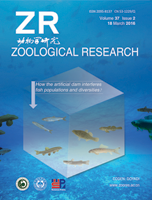
|
Zoological Research
Kunming Institute of Zoology, Chinese Academy of Sciences
ISSN: 2095-8137
Vol. 29, No. 5, 2008, pp. 485-492
|
 Bioline Code: zr08076
Bioline Code: zr08076
Full paper language: Chinese
Document type: Research Article
Document available free of charge
|
|
|
Zoological Research, Vol. 29, No. 5, 2008, pp. 485-492
| en |
Homology Modeling and Molecular Evolution Analysis of Myostatin
XIE, Yu-wei; XUE, Xiao-ping; YIN, Huan-cai; TANG, Rui-hua; SU, Jing; SONG, Kai; HUYAN, Ting; WANG, Hua & YANG, Hui
Abstract
Myostatin (MST) is the cytokine negatively regulated skeletal muscle growth factor, and the loss of function caused by mutations is associated with increased skeletal muscle mass. The multiple sequence alignment of the available MST cDNA sequences and the related evolutionary analyses were performed; the quarternary structures of MST homodimer and the MST: ActRIIB complex was built using homology modelling technique. The phylogenetic tree revealed that there were four sub-families, i.e., mammalian MSTN, avian MSTN, and fish MSTN1, 2 in the MST gene (MSTN) family. MST orthologous genes derived from different species had a high sequence identity, which were probably caused by the purifying selection. Particularly, the high degree of conservation of C-terminal sequences of mammalian and avian MST mature peptides suggested they shared the very similar structure, function and signal transduction pathway. The analyses of electrostatic potential and hydrophobic amino acid distribution of the structural models revealed that the electrostatic force and hydrophobic interaction played an important role in receptor recognition by MST.
Keywords
Myostatin; Molecular evolution; Homology modeling
|
| |
© Copyright 2008 Kunming Institute of Zoology, the Chinese Academy of Sciences
Alternative site location: http://www.zoores.ac.cn/
|
|
